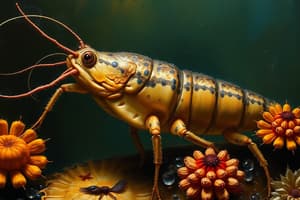Podcast
Questions and Answers
What is the name of the type of dentition found in mammals?
What is the name of the type of dentition found in mammals?
Heterodont
What is the role of the diaphragm in mammals?
What is the role of the diaphragm in mammals?
Respiration
What is the function of the hairs that cover the body of mammals?
What is the function of the hairs that cover the body of mammals?
Prevent the loss of heat from the body
What are the epidermal derivatives that cover the body of mammals?
What are the epidermal derivatives that cover the body of mammals?
What is the specific bone in the lower jaw of mammals called?
What is the specific bone in the lower jaw of mammals called?
What type of limbs do mammals possess?
What type of limbs do mammals possess?
What is the name for the well-developed internal supporting structure in mammals?
What is the name for the well-developed internal supporting structure in mammals?
What are the two types of teeth that appear during the lifetime of mammals?
What are the two types of teeth that appear during the lifetime of mammals?
Which glands in mammals are modified sweat glands?
Which glands in mammals are modified sweat glands?
What is the type of skin glands present in mammals?
What is the type of skin glands present in mammals?
Study Notes
Phylum Chordata
- Phylum Chordata is the most notable phylum, including all human beings, animals, and birds.
- The distinguishing character of all animals in this phylum is the presence of notochord.
- Chordates show four features at different stages in their life:
- Notochord
- Dorsal Nerve Cord
- Post-anal tail
- Pharyngeal slits
Dorsal Nerve Cord
- A bundle of nerve fibers that connects the brain, muscles, and other organs.
- Formation of Nerve Cord: a dorsal, hollow, longitudinal rod made of cartilage, running between the nerve cord and the digestive tract.
- Its main function is to support the nerve cord.
Pharyngeal Slits
- Openings that connect the mouth and the throat.
- Allow the entry of water through the mouth, without entering the digestive system.
Subphylum Craniata
- Occupy almost every environment: surface of the earth, marine and freshwater habitats, and terrestrial habitats.
- Primitive members are agnathans (without jaws), lacking rigid hinged elements supporting the borders of the mouth.
- Most members have the vertebral column that replaces the notochord and are called vertebrates.
- They possess jaws and are known as Gnathostomata.
Common Features of Craniate
- Bilateral symmetry: the arrangement of the organ systems in the right and left halves of the animal is exactly similar.
- Cephalization: the anterior end of the animal is differentiated into a distinct head region.
Body Organization
- Body is divisible into three regions: head, trunk, and tail.
- Possess a well-developed head region and cranium.
- Notochord is replaced by vertebral column either partly or wholly in the adult.
- Nerve cord is differentiated into brain and spinal cord in the adult.
Organ Systems
- Possess well-developed organ systems showing a higher grade of organization and functional efficiency.
- Circulatory system: blood is confined to arteries, veins, and sinusoids with a well-developed muscular heart with two, three, or four chambers.
- Respiratory system: in the lower forms, by paired gills, and in terrestrial species, by lungs.
- Excretory system: the paired excretory organs (kidneys) discharge through ducts or ureters near or through the anus.
- Nervous system: the brain becomes regionally differentiated as to structure and function.
Reproductive System
- The sexes are separate, and each has a pair of gonads.
- Development of the embryos may take place in different ways, and they can be: Oviparous, Ovoviviparous, and Viviparous.
Endocrine Glands
- Provide hormones, transported by the bloodstream, that regulate bodily processes, growth, and reproduction.
Division (i): Agnatha
- Marine or freshwater forms, distinct from other Vertebrates in the absence of jaws and paired fins or appendages.
Division (ii): Gnathostomata
- Higher vertebrates possessing true jaws.
- In most vertebrates, the embryonic notochord is replaced by a vertebral column.
- They are further divided into two superclasses: Pisces and Tetrapoda.
Superclass: Pisces
- Includes cartilaginous and bony fishes.
- Mouth terminal or subterminal with different types of feeding habitats.
- Four pairs of gills present, covered by a flexible plate called an operculum.
- Gills are filamentary type, and an air bladder or swim bladder is often present.
Superclass: Tetrapoda
- Means "four legs".
- All tetrapods have a basic pentadactyl (five-digit) limb structure.
- Amphibians, reptiles, birds, and mammals are the major groups of the Tetrapoda.
- Tetrapods include all land-living vertebrates and also include a number of animals that live in the water, such as sea turtles, sea snakes, whales, and dolphins.
Class: Amphibia
- Amphibians are the first tetrapods showing many transitional modifications from aquatic to terrestrial life.
- The name Amphibia refers to a double life, leading a life both on land and in water.
- They are partially terrestrial, as they have to return to water for breeding and development.
- Cold-blooded vertebrates, viviparous vertebrates which give birth to young ones, except monotremes which are egg-laying mammals.
Studying That Suits You
Use AI to generate personalized quizzes and flashcards to suit your learning preferences.
Description
Learn about the key characteristics of animals in the phylum Chordata, including the presence of a notochord and a dorsal nerve cord. Explore the unique features that define chordates at different life stages.




